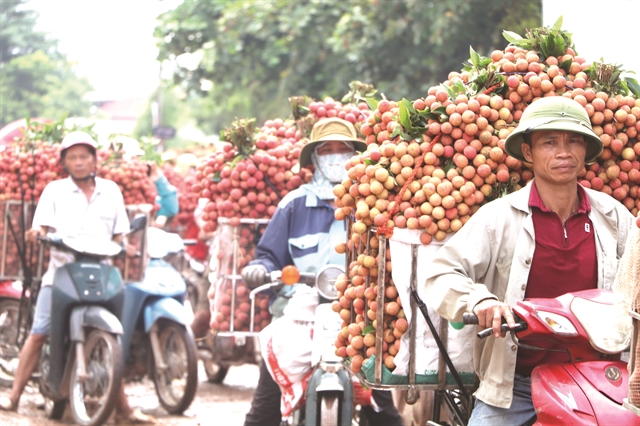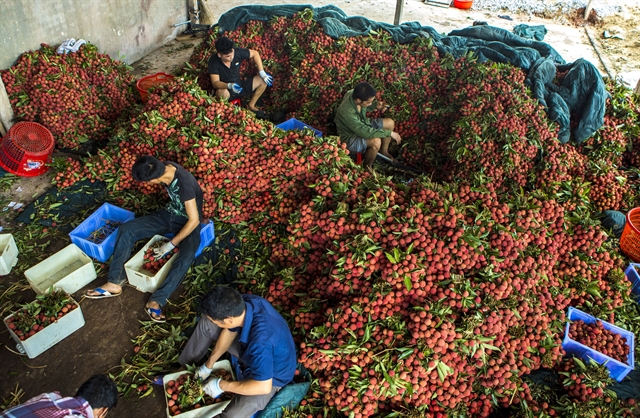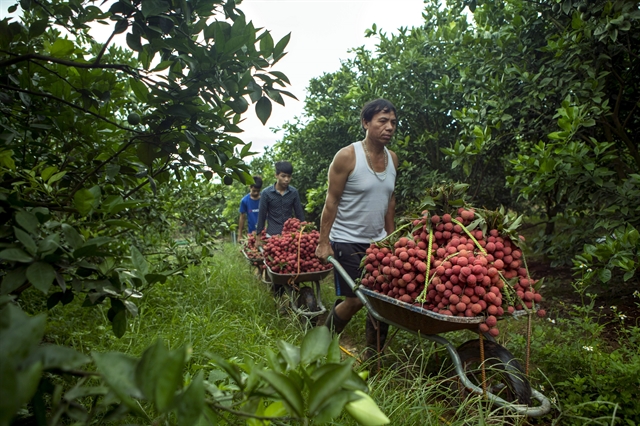
Sweet and salt: Farmers in Lục Ngạn District in the northern province of Bắc Giang take lychee fruits to sell to traders in the summer heat. VNS Photo Hoàng Hồ
by Bảo Hoa, Hoàng Hồ & Paul Kennedy
The road is narrow, dusty and even by Vietnamese standards, extremely busy.
Police officers are on patrol from the crack of dawn. Horns beep, giving off the impression you are in downtown Hà Nội rather than the countryside surrounding the capital.
Overloaded motorbikes jostle for space between lorries and cars.
The air is filled with sounds of bartering and the pleasant sweet aroma of ripened fruit.
This is Lục Ngạn; this is lychee country.
Most of the units on the stretch of road into town have been converted into trading posts. Motorbike drivers impatiently wait on the roadside for their turn in the queue, baskets of the fruit balanced perilously on the seats of their scooters.
Inside the dark sheds, piles and piles of lychee are stacked floor to ceiling, growing by the minute. Scales calculate each load and the figures are accurately recorded.

Trimmed: A worker cuts the lychee fruits off their branches and gets them ready to be packaged. VNS Photo Bảo Hoa
For now the fruit is in Việt Nam. Tomorrow it could be in the US, the UK, Japan or the Czech Republic. Business at the moment is good.
"The total lychee output we are expecting this year is 80,000-90,000 tonnes," said Nguyễn Thanh Bình, chairman of Lục Ngạn District’s People’s Committee. “Of those, output from the early-ripening batches will be about 13,000 tonnes, and output from the main crop will be 67,000-70,000 tonnes.
“We have 18 lychee growing regions receiving plantation region codes from the US, and we are qualified to export lychee to leading international markets,” he added.
“One of our local enterprises has had some batches exported to the US, and we are waiting for reports on consumption. We have also exported a few batches to the Czech Republic and other eastern European countries.”
The northern regions of Việt Nam are the ideal home for lychee production. Warm weather in the summer perfectly complements the colder winter months that are essential to ensure the successful development of the flower buds.

Workers for Trâm Anh Company, which collects and exports lychee to China, sort through the crop. VNA/VNS Photo Hoàng Hùng
Although the actual crop isn’t as big as in previous years, because the price of the fruit has risen so dramatically, the signs are still good for the industry’s future.
“I’m very happy that farmers are having a bumper crop and can sell the lychees at really good prices, which can rise up to VNĐ50,000-60,000 (US$2-2.6) per kilogramme,” said Hoàng Văn Thi, a trader from Hải Dương Province.
“The average price is from VNĐ25,000-30,000 per kilogramme,” he added. “Although it’s not a very excellent crop, the price is really good. And farmers know how to cultivate the lychee trees so the fruit’s quality is good.”
Standards have improved as well, making lychees grown in Việt Nam a more attractive option for the overseas market.
Lục Ngạn chairman Bình said their success is thanks to the hard work of the many farmers who carefully tend their crops to ensure the very best quality.
“Nice weather and the hard work our farmers put in have given the lychee fruits this year the highest quality ever,” he said.
“So far we have been able to sell 20,000 tonnes and have just started our main harvest.”
China remains Việt Nam’s biggest export customer – ironic considering many believe that is where the fruit was first discovered.
The chairman added: “This year they have higher requirements in terms of quality and require us to have plantation region codes. And before the harvest season began, we had 36 growing regions get the codes.
“They also want some enterprises to be certified in product packaging before exporting their products to China, and we have got 82 co-operatives registered and approved.”

Local farmers harvest lychee. VNA/VNS Photo Hoàng Hùng
But it is not all about the overseas market. The authorities also pay attention to selling the fruit here at home.
“In previous years we mainly focused on the southern provinces, HCM City, and Hà Nội, and this is the first year we start to collaborate with the central provinces,” chairman Bình said.
“We are lucky to have (the supermarket chain) Saigon Coop to help us bring some batches to the central city of Đà Nẵng. And we have seen positive signs from these domestic markets.”
But despite a good year, those involved at the ground level cannot rest on their laurels. Competition is strong and they must keep up their high standards.
“For me, the soil here is what makes Lục Ngạn lychee special," said Mai Văn Tuyền, 34, a local lychee trader. "It creates the unique flavour of the lychees with a distinctive sweetness that nowhere else has. It’s our trademark."
Farmer Dương Văn Tuyến, 51, said: “The lychee trees love our soil, so they produce fruits with a beautiful red colour, thick flesh, small seeds and a nice sweet taste.
“Pruning and fertilising are the most important stages to make lychee flowers bloom and bear fruits.
“There’s no difficult technique, and the weather here is already nice. And we always use standard pesticides to ensure their effectiveness.”
Việt Nam is currently the second largest exporter of lychee in the world. Around 19 per cent of the fruit consumed globally is grown right here.
Early signs for the coming year are positive, but to stay at the top of their game all involved in the business must remain dedicated and innovative.
Only then will they continue to enjoy the sweet success of lychee and benefit from the fruits of their labour. VNS
- Unofficial records in China refer to lychee as far back as 2000 BC
- There are many stories in Chinese tradition of lychee being used as a delicacy in the Chinese Imperial Court
- Lychee is a medium-sized tree that can reach 12 to 15 metres in height
- It alleviates pain associated with kidney stones and reduces the formation of blood clots
- Lychee is a perennial plant that can survive around 1,000 years in the wild
- The fruit is a symbol of love and romance in China
- Lychee attracted attention of European travellers, such as Juan Gonzalez de Mendoza, based on the reports of Spanish friars who had visited China in the 1570s giving the fruit high praise
OVietnam